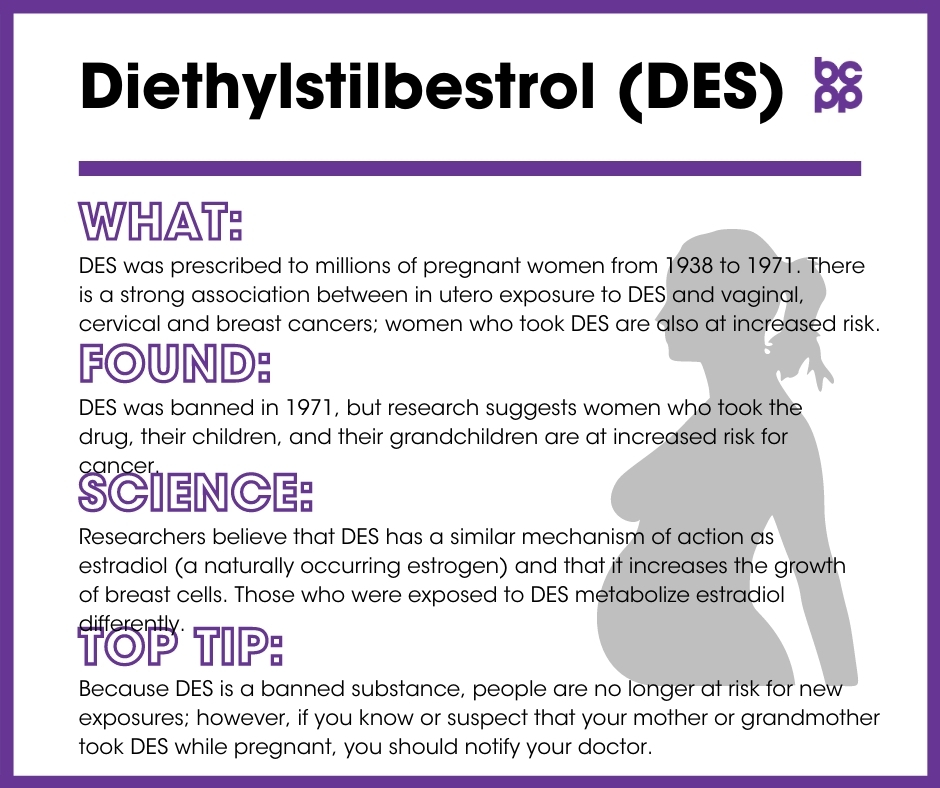Diethylstilbestrol (DES)
At a Glance
Diethylstilbestrol (DES), was prescribed to millions of pregnant women from 1938 to 1971 to help prevent pregnancy complications.
In the late 1960s, doctors realized that there was a strong association between in utero exposure to DES and the incidence of rare vaginal and cervical cancer in young women and girls.
It was later discovered that exposure to DES was also associated with an increased risk of developing breast cancer. DES was banned in the United States in 1971.

What is DES?
DES was one of the first synthetic estrogens ever developed. It was prescribed by doctors to help prevent pregnancy complications, including miscarriage and preterm delivery.[1] In the late 1960s, clusters of young women and pubescent girls were diagnosed with rare vaginal and cervical cancers. Doctors soon determined that the patients had one thing in common: Their mothers had taken DES during their pregnancies.[2],[3],[4] DES became the first identified cause of “prenatal drug-induced cancer in humans”[5] and was subsequently banned in 1971.
Where is DES found?
Although DES was banned in 1971, it continues to affect women who took the drug while pregnant as well as DES sons and daughters (male and female offspring exposed in utero).[6],[7] There is also a growing body of evidence suggesting that grandchildren of women who took DES while pregnant could be impacted, a group known as DES third generation.[8]
What evidence links DES to breast cancer?
- Researchers believe that DES has a similar mechanism of action as estradiol (a naturally occurring estrogen)[9] and that, like estradiol, it can increase the growth of breast cells.[10] In addition, postmenopausal women exposed to DES in utero metabolized estradiol differently than those who were not exposed. Because of this, DES-exposed women had a general estrogen profile that has been associated with an increased risk for developing breast cancer.[11]
- Studies following women who took DES in the 1950s show that they have an increased risk of developing breast cancer compared to the general population.[12],[13]
- Likewise, studies looking at health outcomes in DES daughters have shown that these women have almost twice the risk of developing breast cancer as women who were not exposed to DES in utero.[14],[15]
- Exposure to high concentrations of DES in utero is also associated with severe abnormalities in vaginal epithelial cells. Women with the most severe abnormalities in these cells have an especially high risk of developing breast cancer.[16]
- DES sons are at risk for developing non-cancerous epididymal cysts.[17] There is also some evidence that DES sons may have a higher likelihood of being born with undescended testes, incorrect placement of the urethral opening of the penis (hypospadias), or being born with a penis that is smaller than normal;[18] however, these research findings have been somewhat inconsistent.
Who is most likely to be exposed to DES?
Women who had a history of difficult pregnancies, including miscarriages and premature deliveries, between 1938 and 1971 are at risk of having been prescribed DES for subsequent pregnancies. The babies they were pregnant with were thus exposed to DES in utero and are at higher risk for developing breast cancer.[19]
Who is most vulnerable to the health effects of DES?
Women who were prescribed DES while pregnant, men and women who were exposed to DES while in the womb (DES daughters and sons), and the grandchildren of women who took DES while pregnant (DES third generation) are all vulnerable to the health effects of DES.[20] This is an example of trans-generational effects that go beyond those directly exposed.
What are the top tips to avoid exposure to DES?
Because DES is a banned substance, people are no longer at risk for new exposures; however, if you know or suspect that your mother or grandmother took DES while pregnant, you should notify your doctor.
Additional Resources
There are several resources for women and men whose mothers and grandmothers took DES during their pregnancies. Below are some sites where you can go to get more information on DES, potential health implications of exposure, and research updates including ongoing animal, clinical and epidemiological studies being conducted to better understand the long-term, multigenerational health effects of DES in humans:
- Centers for Disease Control (CDC) DES Update: http://www.cdc.gov/des/index.html
- This website is no longer updated, meaning some of the information found there may be out of date. However, it does provide useful information on DES, including history and known health effects
- CDC also provides a listing of advocacy groups for exposed individuals: http://www.cdc.gov/des/consumers/resources/org_advocacy.html
- DES Action: http://www.desaction.org/
- This group has put together a thorough list of online resources: http://www.desaction.org/online-resources/
Updated 2019
[2] Hoover, Robert N. et al. “Adverse health outcomes in women exposed in utero to diethylstilbestrol.” New England Journal of Medicine 365, 14 (2011): 1304–1314. doi:10.1056/NEJMoa1013961.
[3] Bibbo, M et al. “Follow-up study of male and female offspring of DES-exposed mothers.” Obstetrics and Gynecology 49, 1 (1977): 1-8.
[4] Herbst, A.L. and Scully, R.E. “Adenocarcinoma of the vagina in adolescence. A report of 7 cases including 6 clear‐cell carcinomas (so‐called mesonephromas).” Cancer 25 (1970): 745-757. doi:10.1002/1097-0142(197004)25:4<745::AID-CNCR2820250402>3.0.CO;2-2.
[5] Herbst, Arthur L, Howard Ulfelder and David C. Poskanzer. “Adenocarcinoma of the vagina: Association of maternal stilbestrol therapy with tumor appearance in young women.” New England Journal of Medicine 284 (1971): 878–881. doi:10.1056/NEJM197104222841604.
[6] Palmer, Julie R et al. “Prenatal diethylstilbestrol exposure and risk of breast cancer.” Cancer Epidemiology, Biomarkers & Prevention 15, 8 (2006): 1509-14. doi:10.1158/1055-9965.EPI-06-0109.
[7] Bibbo, M et al. “Follow-up study of male and female offspring of DES-exposed mothers.” Obstetrics and Gynecology 49, 1 (1977): 1-8.
[8] Centers for Disease Control. “DES Update Home: For Consumers, Health Care Providers, and DES Update Partners.” Last modified October 5, 2011. http://www.cdc.gov/des/index.html.
[9] Saeed, Muhammad et al. “Mechanism of metabolic activation and DNA adduct formation by the human carcinogen diethylstilbestrol: the defining link to natural estrogens.” International Journal of Cancer 124, 6 (2009): 1276-84. doi:10.1002/ijc.24113.
[10] Larson, Pamela S et al. “In utero exposure to diethylstilbestrol (DES) does not increase genomic instability in normal or neoplastic breast epithelium.” Cancer 107, 9 (2006): 2122-6. doi:10.1002/cncr.22223.
[11] Troisi, Rebecca et al. “Estrogen metabolism in postmenopausal women exposed in Utero to diethylstilbestrol.” Cancer Epidemiology, Biomarkers and Prevention 27, 10 (2018): 1208–13. doi:10.1158/1055-9965.EPI-18-0135.
[12] Colton, T et al. “Breast cancer in mothers prescribed diethylstilbestrol in pregnancy. Further follow-up.” JAMA 269, 16 (1993): 2096-100.
[13] Titus-Ernstoff, L et al. “Long-term cancer risk in women given diethylstilbestrol (DES) during pregnancy.” British Journal of Cancer 84, 1 (2001): 126-33. doi:10.1054/bjoc.2000.1521.
[14] Palmer, Julie R et al. “Prenatal diethylstilbestrol exposure and risk of breast cancer.” Cancer Epidemiology, Biomarkers & Prevention 15, 8 (2006): 1509-14. doi:10.1158/1055-9965.EPI-06-0109.
[15] Troisi, Rebecca et al. “Cancer risk in women prenatally exposed to diethylstilbestrol.” International Journal of Cancer 121 (2007): 356–360. doi:10.1002/ijc.22631.
[16] Hoover, Robert N. et al. “Adverse health outcomes in women exposed in utero to diethylstilbestrol.” New England Journal of Medicine 365, 14 (2011): 1304–1314. doi:10.1056/NEJMoa1013961.
[17] Bibbo, M et al. “Follow-up study of male and female offspring of DES-exposed mothers.” Obstetrics and Gynecology 49, 1 (1977): 1-8.
[18] Centers for Disease Control. “DES Update Home: For Consumers, Health Care Providers, and DES Update Partners.” Last modified October 5, 2011. http://www.cdc.gov/des/index.html.
[19] Centers for Disease Control. “DES Update Home: For Consumers, Health Care Providers, and DES Update Partners.” Last modified October 5, 2011. http://www.cdc.gov/des/index.html.
[20] Centers for Disease Control. “DES Update Home: For Consumers, Health Care Providers, and DES Update Partners.” Last modified October 5, 2011. http://www.cdc.gov/des/index.html.





